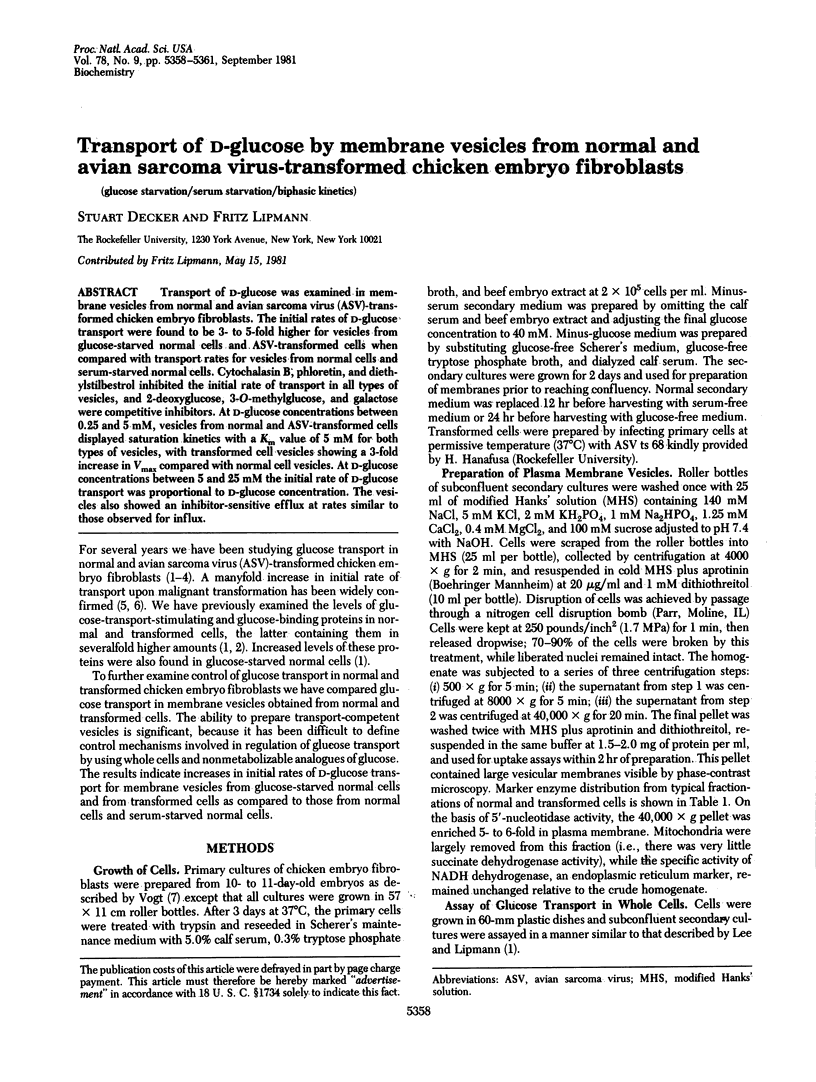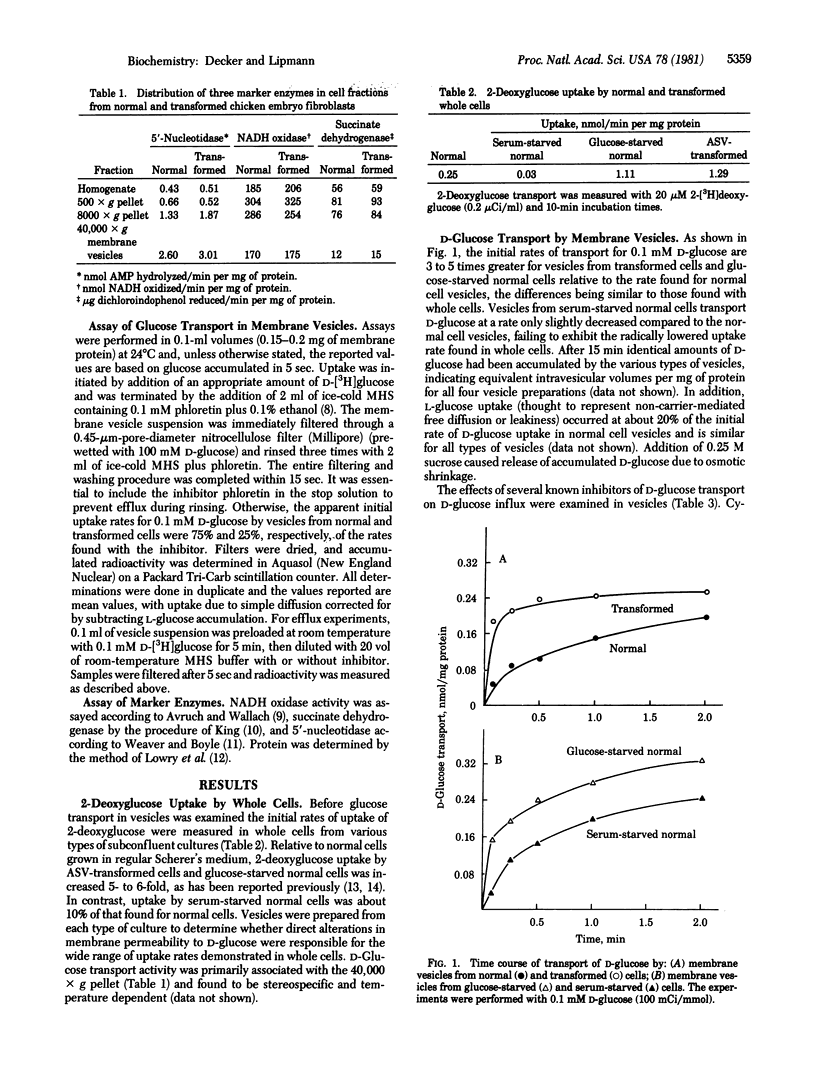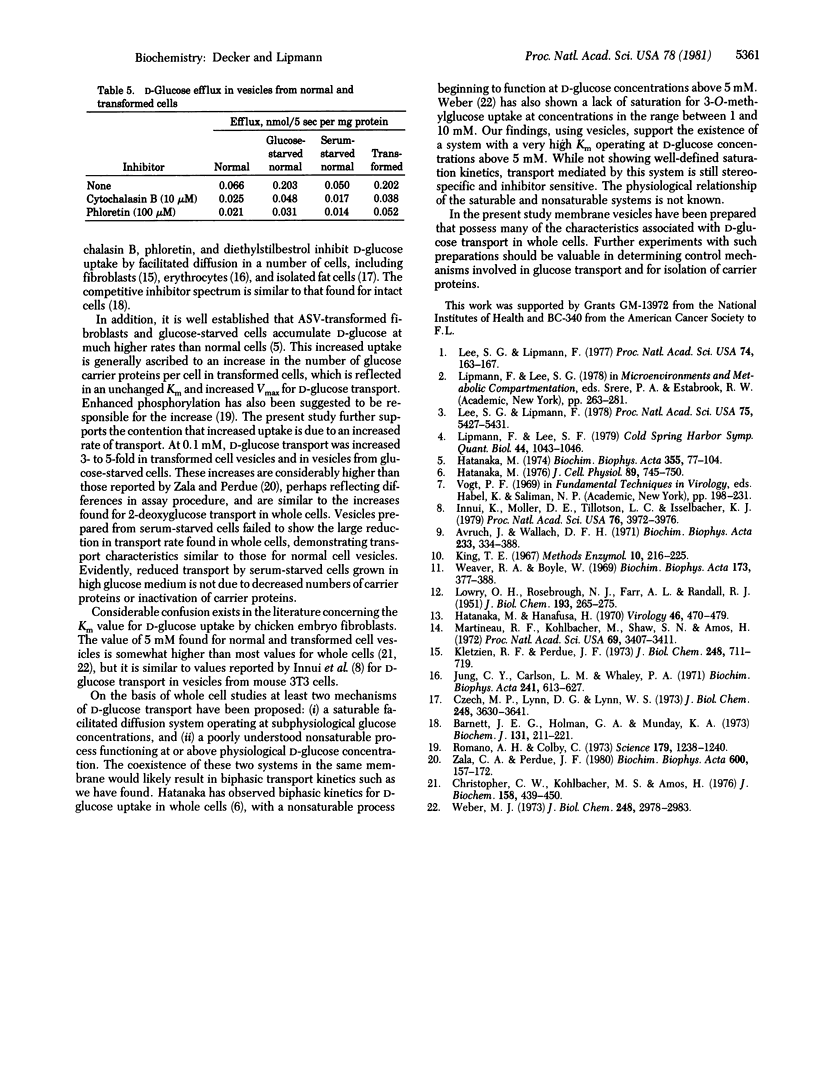Abstract
Transport of D-glucose was examined in membrane vesicles from normal and avian sarcoma virus (ASV)-transformed chicken embryo fibroblasts. The initial rates of D-glucose transport were found to be 3- to 5-fold higher for vesicles from glucose-starved normal cells and ASV-transformed cells when compared with transport rates for vesicles from normal cells and serum-starved normal cells. Cytochalasin B, phloretin, and diethylstilbestrol inhibited the initial rate of transport in all types of vesicles, and 2-deoxyglucose, 3-O-methylglucose, and galactose were competitive inhibitors. At D-glucose concentrations between 0.25 and 5 mM, vesicles from normal and ASV-transformed cells displayed saturation kinetics with a Km value of 5 mM for both types of vesicles, with transformed cell vesicles showing a 3-fold increase in Vmax compared with normal cell vesicles. At D-glucose concentrations between 5 and 25 mM the initial rate of D-glucose transport was proportional to D-glucose concentration. The vesicles also showed an inhibitor-sensitive efflux at rates similar to those observed for influx.
Full text
PDF



Selected References
These references are in PubMed. This may not be the complete list of references from this article.
- Avruch J., Wallach D. F. Preparation and properties of plasma membrane and endoplasmic reticulum fragments from isolated rat fat cells. Biochim Biophys Acta. 1971 Apr 13;233(2):334–347. doi: 10.1016/0005-2736(71)90331-2. [DOI] [PubMed] [Google Scholar]
- Barnett J. E., Holman G. D., Munday K. A. Structural requirements for binding to the sugar-transport system of the human erythrocyte. Biochem J. 1973 Feb;131(2):211–221. doi: 10.1042/bj1310211. [DOI] [PMC free article] [PubMed] [Google Scholar]
- Christopher C. W., Kohlbacher M. S., Amos H. Transport of sugars in chick-embryo fibroblasts. Evidence for a low-affinity system and a high-affinity system for glucose transport. Biochem J. 1976 Aug 15;158(2):439–450. doi: 10.1042/bj1580439. [DOI] [PMC free article] [PubMed] [Google Scholar]
- Czech M. P., Lynn D. G., Lynn W. S. Cytochalasin B-sensitive 2-deoxy-D-glucose transport in adipose cell ghosts. J Biol Chem. 1973 May 25;248(10):3636–3641. [PubMed] [Google Scholar]
- Hatanaka M. Saturable and nonsaturable process of sugar uptake: effect of oncogenic transformation in transport and uptake of nutrients. J Cell Physiol. 1976 Dec;89(4):745–749. doi: 10.1002/jcp.1040890435. [DOI] [PubMed] [Google Scholar]
- Hatanaka M. Transport of sugars in tumor cell membranes. Biochim Biophys Acta. 1974 Apr 29;355(1):77–104. doi: 10.1016/0304-419x(74)90008-0. [DOI] [PubMed] [Google Scholar]
- Inui K. I., Moller D. E., Tillotson L. G., Isselbacher K. J. Stereospecific hexose transport by membrane vesicles from mouse fibroblasts: membrane vesicles retain increased hexose transport associated with viral transformation. Proc Natl Acad Sci U S A. 1979 Aug;76(8):3972–3976. doi: 10.1073/pnas.76.8.3972. [DOI] [PMC free article] [PubMed] [Google Scholar]
- Jung C. Y., Carlson L. M., Whaley D. A. Glucose transport carrier activities in extensively washed human red cell ghosts. Biochim Biophys Acta. 1971 Aug 13;241(2):613–627. doi: 10.1016/0005-2736(71)90059-9. [DOI] [PubMed] [Google Scholar]
- Kletzien R. F., Perdue J. F. The inhibition of sugar transport in chick embryo fibroblasts by cytochalasin B. Evidence for a membrane-specific effect. J Biol Chem. 1973 Jan 25;248(2):711–719. [PubMed] [Google Scholar]
- LOWRY O. H., ROSEBROUGH N. J., FARR A. L., RANDALL R. J. Protein measurement with the Folin phenol reagent. J Biol Chem. 1951 Nov;193(1):265–275. [PubMed] [Google Scholar]
- Lee S. G., Lipmann F. Glucose binding and transport proteins extracted from fast-growing chicken fibroblasts. Proc Natl Acad Sci U S A. 1978 Nov;75(11):5427–5431. doi: 10.1073/pnas.75.11.5427. [DOI] [PMC free article] [PubMed] [Google Scholar]
- Lee S. G., Lipmann F. Isolation from normal and Rous sarcoma virus-transformed chicken fibroblasts of a factor that binds glucose and stimulates its transport. Proc Natl Acad Sci U S A. 1977 Jan;74(1):163–167. doi: 10.1073/pnas.74.1.163. [DOI] [PMC free article] [PubMed] [Google Scholar]
- Lipmann F., Lee S. G. Isolation of a glucose transport system from normal chicken fibroblasts and from chicken fibroblasts transformed by Rous sarcoma virus. Cold Spring Harb Symp Quant Biol. 1980;44(Pt 2):1043–1046. doi: 10.1101/sqb.1980.044.01.112. [DOI] [PubMed] [Google Scholar]
- Martineau R., Kohlbacher M., Shaw S. N., Amos H. Enhancement of hexose entry into chick fibroblasts by starvation: differential effect on galactose and glucose. Proc Natl Acad Sci U S A. 1972 Nov;69(11):3407–3411. doi: 10.1073/pnas.69.11.3407. [DOI] [PMC free article] [PubMed] [Google Scholar]
- Romano A. H., Colby C. SV40 virus transformation of mouse 3T3 cells does not specifically enhance sugar transport. Science. 1973 Mar 23;179(4079):1238–1240. doi: 10.1126/science.179.4079.1238. [DOI] [PubMed] [Google Scholar]
- Weaver R. A., Boyle W. Purification of plasma membranes of rat liver. Application of zonal centrifugation to isolation of cell membranes. Biochim Biophys Acta. 1969 Apr;173(3):377–388. doi: 10.1016/0005-2736(69)90003-0. [DOI] [PubMed] [Google Scholar]
- Weber M. J. Hexose transport in normal and in Rous sarcoma virus-transformed cells. J Biol Chem. 1973 May 10;248(9):2978–2983. [PubMed] [Google Scholar]
- Zala C. A., Perdue J. F. Stereospecific D-glucose transport in mixed membrane and plasma membrane vesicles derived from cultured chick embryo fibroblasts. Biochim Biophys Acta. 1980 Jul 16;600(1):157–172. doi: 10.1016/0005-2736(80)90421-6. [DOI] [PubMed] [Google Scholar]


